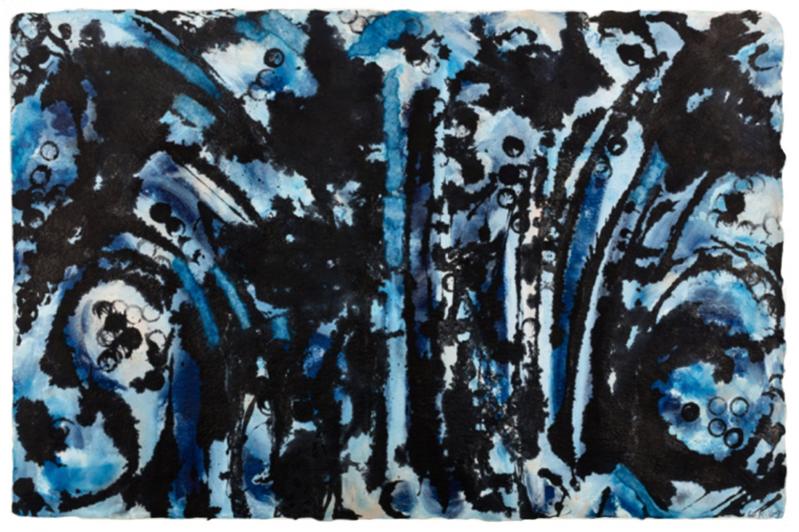Back in grad school, a classmate who was taking a seminar on Jackson Pollock and Lee Krasner opined that Krasner was a much better artist and that Pollock was minor compared to her.
At that point, many years ago, Krasner had not registered much on my radar, but Pollock was clearly in the upper echelon of the pantheon of Abstract Expressionist painters. Although inclined not to agree, the comment, and the urge to know why it was said, still stuck.
As a result, I made a point of seeking out Krasner shows when they popped up at the former Robert Miller Gallery, then at Kasmin Gallery, and other venues both commercial and institutional, growing more impressed with each encounter. (This became even easier after being hired by The Star and focusing on the East End art colonies.)
A practicing artist for almost three decades after Pollock's death, Krasner had time to grow and develop in ways that he never had. The notorious artistic block that grew after the worldwide recognition of his drip paintings led to his depression and untimely demise.
With all that said, I am now inclined to agree with that classmate, particularly after seeing the Pollock-Krasner House and Study Center's latest exhibition (and the last under the direction of Helen Harrison, who will retire at the end of the year), "Lee Krasner: Portrait in Green."
In her long career, Krasner adopted a multitude of styles and working methods. As a result, her work from different periods is often surprising and fresh. Her ability to abandon styles, and even kill them at times, literally cutting up previous works -- her own and Pollock's -- to make new collages, was particularly radical in an era defined by the triumphant (almost always male) artist and his precious output.
The center's exhibition focuses on one year in her career, 1969, and the one painting on canvas she executed that year. The painting is of significance for that reason, but also because it was the only known time she was photographed actually painting one of her canvases. The show consists of that canvas, "Portrait in Green," five photographs of the artist at work on it, and a series of gouaches on paper that otherwise occupied her during that year.

The leviathan of a canvas, measuring around 5 feet by 8 feet, is impressive, as are Mark Patiky's photographs of Krasner painting it. But it's the easel-sized gouaches on paper that generate the most heat.
Their deep and rich color and barely contained exuberance mimic the canvas, which is, as described, painted in a very particular shade of green, more blue than yellow, something that seems derived from the sea, bright but brackish, alive with movement and gesture.
Krasner didn't always title the gouaches (made with opaque watercolor pigments) from the period, but when she did they had four themes: "earth," "hieroglyph," "seed," and "water." Some seem self-explanatory, like "Water No. 14" or "Earth No. 7," given their color scheme. But just when it seems obvious, the predominantly pink and tiny "Water No. 20" blows all theories out of the water. That she made some of these works in her bathtub could also explain that particular group, but not the rest. It's all pretty complicated.
"Hieroglyph" is a reference back to a series of paintings Krasner made in the 1940s when she had only a table in an upstairs bedroom in the Springs house to use as her studio. Some of these paintings contained a grid of unknowable symbols or imaginary letters that seemed like a made-up language.
In any case, her process of staining the handmade paper with pigment and then painting forms and lines on it yields fields of rich color in various depths and intensities. The medium is important to this result, but the paper is singular in making these drawings as rich and vital as they are, practically pulsating with some kind of life force.
Each one is made on Howell paper, named after its creator, Douglass Morse Howell. In an essay on Krasner and the use of the paper, Ms. Harrison said that Howell was a banker and literary agent before serving in World War II. He stayed in France after the war, which is where he learned the method of waterleaf papermaking. This consists of a wet pulp of fabric or organic material that is screened to drain off the liquid, leaving a rough and absorbent residue in the form of a sheet of paper. He used damask tablecloths, dishtowels, napkins, and other linens as the source of his fibers. Back in Westbury, he set up shop, where the Pollocks became customers in 1951.
Pollock used the paper for a series of ink drawings. The paper first entered Krasner's oeuvre in her 1954 collages, which took some of Pollock's drawings as source material. Then, in 1969, she began using it as support for her own compositions, recognizing that she could soak it to create thinner, translucent areas of color.
Ms. Harrison notes that Krasner told Phyllis Braff and The Star in 1980, "With the water-dipping technique I could get great varieties" out of the monochromatic compositions by playing up the paper's high rate of absorption. "You might say I was pushing, with the fixed points just the gouache and paper."
Moving back to the painting on canvas, one can see some of the same energy and color variations at work, translating some of the properties of the watercolor into different intensities of the oil paint.
In an exchange recorded in Ellen Landau's catalogue raisonne of her work, Krasner explained to the art historian that "every once in a while I feel the need to break my medium, and if I am working in oil, I feel the need to change" it. In 1969, in particular, it was a detour worth taking.
The show is on view through Oct. 29.




